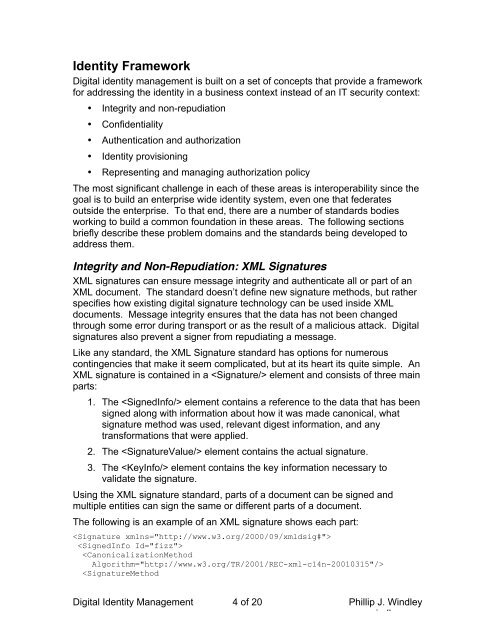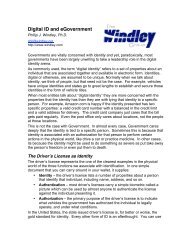Understanding Digital Identity Management - Phil Windley's ...
Understanding Digital Identity Management - Phil Windley's ...
Understanding Digital Identity Management - Phil Windley's ...
Create successful ePaper yourself
Turn your PDF publications into a flip-book with our unique Google optimized e-Paper software.
<strong>Identity</strong> Framework<strong>Digital</strong> identity management is built on a set of concepts that provide a frameworkfor addressing the identity in a business context instead of an IT security context:• Integrity and non-repudiation• Confidentiality• Authentication and authorization• <strong>Identity</strong> provisioning• Representing and managing authorization policyThe most significant challenge in each of these areas is interoperability since thegoal is to build an enterprise wide identity system, even one that federatesoutside the enterprise. To that end, there are a number of standards bodiesworking to build a common foundation in these areas. The following sectionsbriefly describe these problem domains and the standards being developed toaddress them.Integrity and Non-Repudiation: XML SignaturesXML signatures can ensure message integrity and authenticate all or part of anXML document. The standard doesn’t define new signature methods, but ratherspecifies how existing digital signature technology can be used inside XMLdocuments. Message integrity ensures that the data has not been changedthrough some error during transport or as the result of a malicious attack. <strong>Digital</strong>signatures also prevent a signer from repudiating a message.Like any standard, the XML Signature standard has options for numerouscontingencies that make it seem complicated, but at its heart its quite simple. AnXML signature is contained in a element and consists of three mainparts:1. The element contains a reference to the data that has beensigned along with information about how it was made canonical, whatsignature method was used, relevant digest information, and anytransformations that were applied.2. The element contains the actual signature.3. The element contains the key information necessary tovalidate the signature.Using the XML signature standard, parts of a document can be signed andmultiple entities can sign the same or different parts of a document.The following is an example of an XML signature shows each part:






